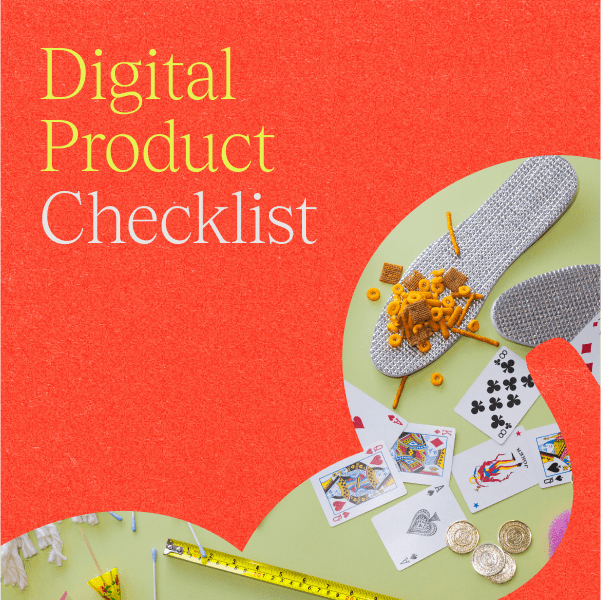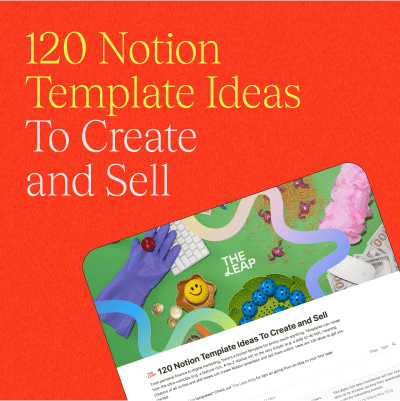For many creators, figuring out how to monetize their work is a constant challenge. If you’re reading this article, you’ve probably got your content game down and have built an audience online, but you wish you were making more money.
While you could grind out more hours creating content in hopes of going viral, there’s a better and more sustainable way to make money online without burning yourself out: creating and selling digital products.
Read on to learn what digital products are, why many creators are selling them, and how you can make your own. To keep this resource at your fingertips, download our 6-Step Digital Product Launch Checklist.
What are digital products?
A digital product is anything you can sell online that doesn’t require manufacturing, shipping, or inventory space. If you can make it on a device (like a phone or computer), sell it on a device, and use it on a device, it’s probably a digital product.
Digital products are a huge part of what we consume every day, from downloadable templates and guides, to online courses and membership subscriptions. They have gained a ton of popularity in the last few years, and the market for them has exploded right along with the boom of the creator economy.
Click here to start creating and selling digital products with The Leap. It’s free!6 Digital product ideas to sell online
So, what kind of digital products can you sell online? If you need some inspiration to get started, here are some of the best digital product ideas.
1. Templates
Digital templates can come in many different forms, but they all serve the same purpose: they’re a fill-in-the-blank solution for common problems. You can create a template for almost anything — think résumé templates for jobseekers, digital wedding planners for brides and grooms-to-be, worksheet templates for teachers, Instagram Stories templates for brands and content creators, and expense tracker templates for anyone looking to manage their finances. The possibilities are endless.
Selling thoughtfully designed templates online could be incredibly lucrative. Creator Easlo, for instance, started making and selling templates that can be used on the productivity tool Notion in 2021. As of 2023, he’s made his first million dollars largely thanks to his template sales.
To start selling, think about what people need and come up with a template that can help make their lives easier. Once you’ve created the template, you can sell it by launching an online storefront with a free tool like The Leap.
Wondering what templates you can sell? Access our free Notion Template Ideas Database for 120 popular examples!
2. Ebooks
Writing an ebook is a great way to share your knowledge and expertise. The startup cost is minimal — you simply need to spend the time to write the content and potentially hire an editor. No matter what your niche is, you can easily find a topic or two that people will be willing to pay to learn about.
Once you’re ready to publish your ebook, you can then use a free online storefront tool like The Leap to sell it. Here’s a step-by-step guide on how to do it.
3. Online courses
Popular among content creators, selling online courses is a fantastic way to make money online. If you have knowledge or expertise to share with others, you can package it into a course and give your audience access to it for a fee.
Just look at Miss Excel, who started her creator journey by sharing Excel spreadsheet tips on TikTok in 2020. Nearly four years later, she’s built a $2 million business selling multiple online courses on how to use Excel and other softwares.
Since you only have to plan, record, and publish your course once and can then sell it repeatedly, online courses can be a great source of passive income.
Pro tip: If you’re new to building online courses, consider starting small by creating and selling a mini-course. With The Leap’s AI-powered digital product builder, not only is it quick and effortless for you to build a mini-course, but the bite-sized format also makes the course content easily digestible for learners. Try The Leap to build your own mini-course today.
4. Guides and tutorials
Guides and tutorials are simple, lightweight alternatives to online courses that you can create quickly and that your audience can get through easily. With guides and tutorials, you’re essentially sharing bite-sized versions of your expertise.
These digital products make for effective lead magnets, i.e. resources you can offer for free in exchange for someone’s email address. By collecting those contacts and building your email list, you’re able to seamlessly promote higher-priced products to your potential customers in the future.
Interested in creating and offering your own guide or tutorial? The Leap’s AI-powered digital product builder can help bring your idea to life in minutes — try it yourself!
5. Digital tools
Digital tools can be anything that helps someone achieve a specific task more efficiently. Whether it’s a photo-editing preset, a Procreate brush, or even a mortgage calculator, you can distill your expertise or skill into a convenient tool to serve others.
6. Printable art and craft patterns
Whether you’re an artist, graphic designer, or knitter, your skills are the gateway to creating digital products for your audience. If you’re an painter, you can sell downloadable art prints to those looking to decorate their spaces. And if you’re a knitwear designer, you can sell patterns of your unique designs in PDFs.
Not sure what to sell? Take this free mini-course to learn how to research and plan which digital products to sell.
6 Steps to sell digital products online
Selling digital products may seem daunting, but it doesn’t have to be. With our 6-Step Digital Product Launch Checklist, you can have an easy-to-follow guide at hand for when you’re planning your launch, whether it’s your first product or your 10th.
How to sell digital products online
- Do some research.
- Create your digital product.
- Set up your online store.
- Promote your product with content.
- Build an email list.
- Try paid advertising.
1. Research

The first step to selling digital products online is to figure out what you’re going to sell, of course. Even though digital products are easier to create than physical goods, you need to make sure the juice is worth the squeeze.
Identify the best digital product for your audience
Before you start building your product, you need to know who you’re creating it for. You could create the best Excel template out there, but it won’t really get you anywhere if no one in your audience uses Excel. Try using community and polling features on your platform of choice to get a sense of what your audience wants.
Do some keyword research
Once you’ve decided what product you’ll be selling, you need to know what to call it. Sure, you might think of it as a “income and expense worksheet,” but your potential customers might call it a “monthly budget tracker.” To increase the reach of your product, you can use a tool like Google Trends to find out what keywords get the most search traffic, and use these keywords when talking about your product.
Scope out the competition
You probably won’t be the first person to sell whatever product you’ve settled on, and that’s a good thing. Go have a look at what others are selling, how they’re marketing their products, and how much they’re charging. Make sure to check out common online marketplaces for existing products out there.
Plan your product from idea to launch
Now that you’ve done your research, it’s time to figure out the production process. Try to get an idea of what resources you’ll need to create this product, whether that’s tools, skilled help, or cash. Give yourself a generous deadline, and plan out how you’ll promote your product when it’s done.
2. Create your digital product

This is the hard part, but it can be a lot of fun too! You’ve made your plan, and now it’s time to actually create something your audience will get excited about.
Start small
Avoid doing too much at once — you don’t want to burn yourself out without ever finishing your product. If you are a beginner in selling digital products, start with a bite-sized idea rather than an elaborate and time-intensive one.
For example, you can create a simple template, a shorter ebook, or a mini-course instead of a full-fledged one. This is your opportunity to learn the process and figure out the kinks.
Build your digital product with The Leap
Since digital products already cost a lot less to produce than physical products, you might as well try to push that advantage to its limit. Instead of using expensive, complicated software, save costs by building your digital product with The Leap.
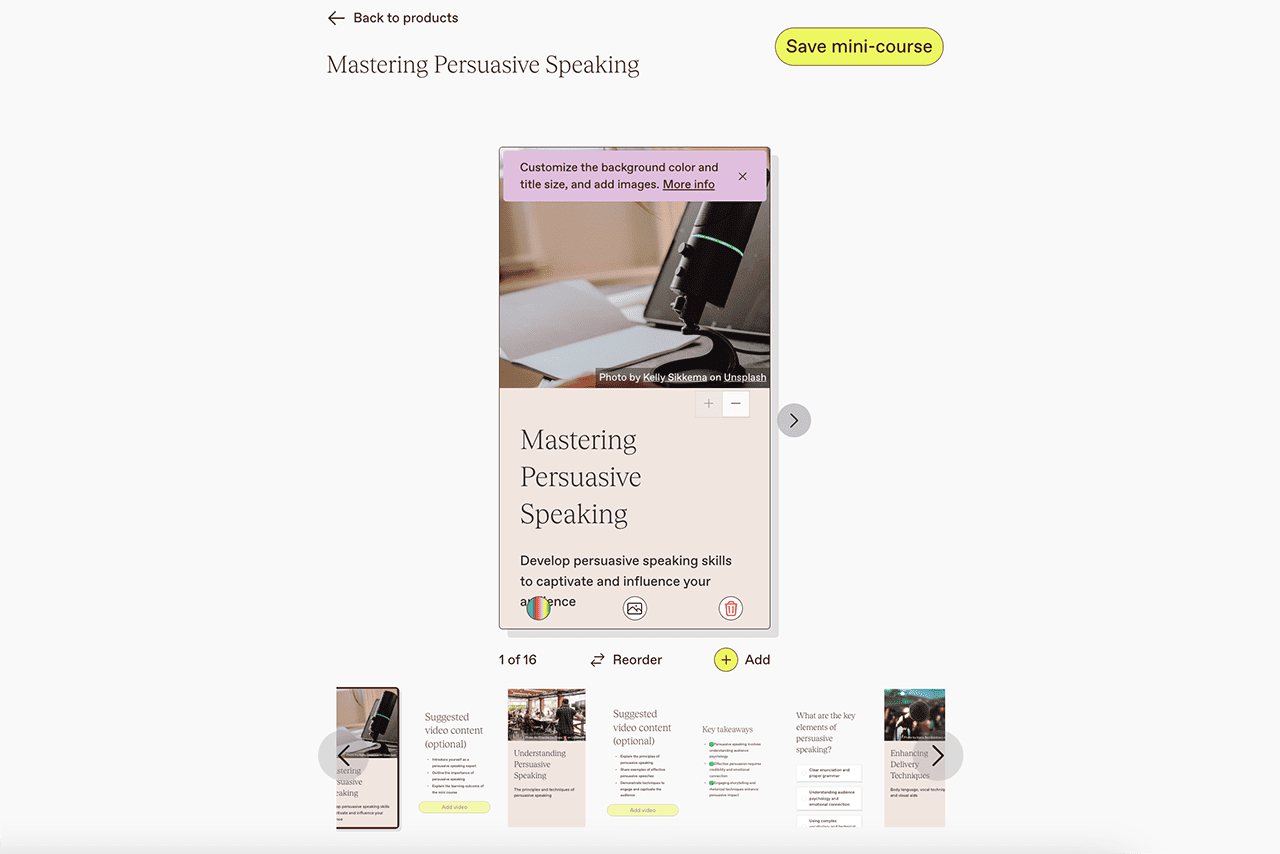
The Leap is a free, AI-powered tool that can help you turn an idea into a marketable digital product in minutes. Whether you’re looking to build a mini-course, tutorial, or guide, The Leap will walk you through the process step by step. Within minutes, The Leap can generate a bunch of digital product ideas for you, and even get you started with a draft.
Try The Leap free today to create and sell your own digital products!
3. Set up your online store

Congratulations, you’ve created your first digital product! Now, it’s time to sell it.
Before you send your product out to the world, you need a way to get it to your audience and have them pay for it. How? You can do so easily by setting up your own online storefront on The Leap.
Step 1: Add your digital product to your store
When you use The Leap to create your digital products, you’ll get a sales page that’s automatically generated and added to your Leap online store.
Got an existing digital product? Or did you build your product elsewhere? No problem! You can sell any digital download on your Leap storefront by pasting a link to wherever it’s hosted.
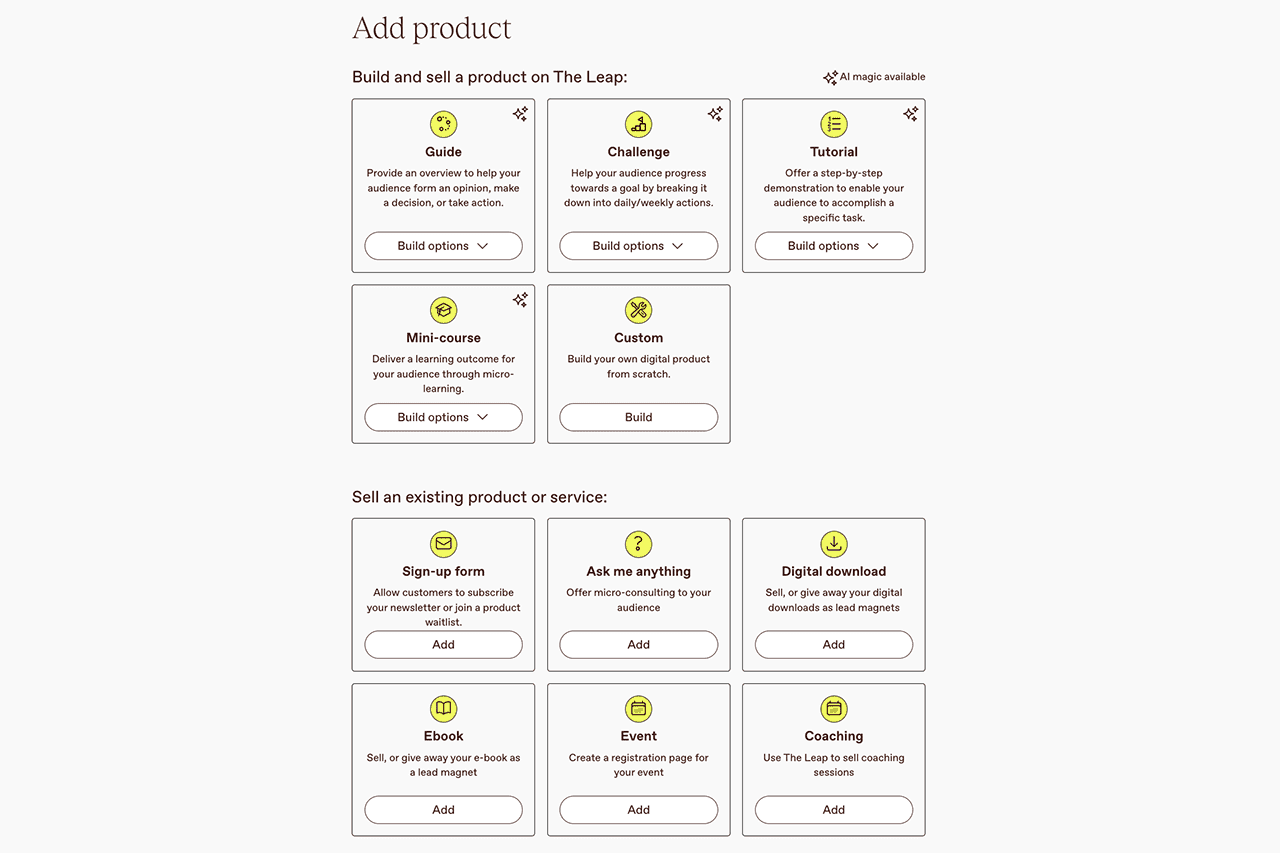
Step 2: Edit your product landing page
Draw the attention of your potential customers by writing a detailed and compelling description of your product. Don’t forget to upload an eye-grabbing image to your sales page!
Here’s an example of a product landing page from creator Kate Terentieva, who sells a mini-course on “How To Become a Creative Director.”
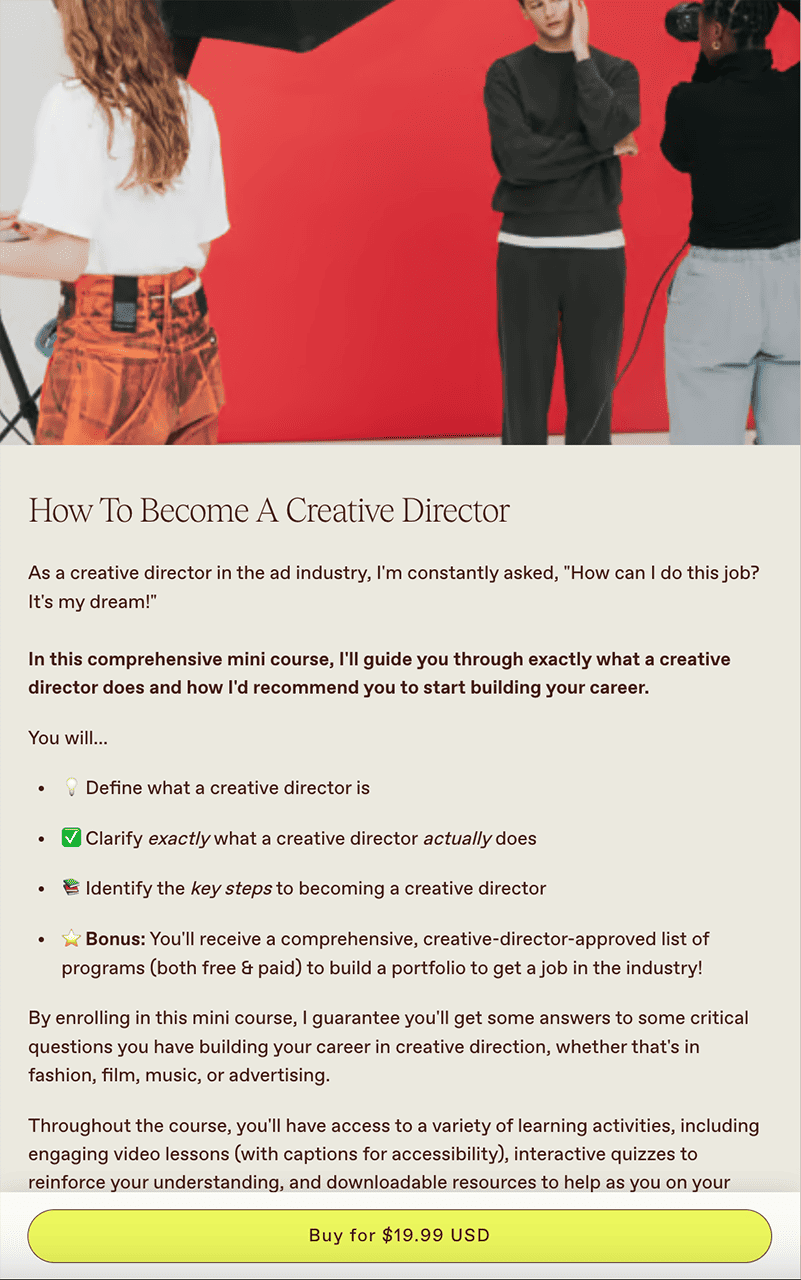
Step 3: Set a price
On The Leap, you can offer your digital products at three different pricing options, including:
- Lead magnet: Offer your product for free in exchange for someone’s email address.
- Fixed price: Decide exactly how much you want to charge for your product.
- Pay what you want: Let your customers decide how much they’d like to pay for your product.
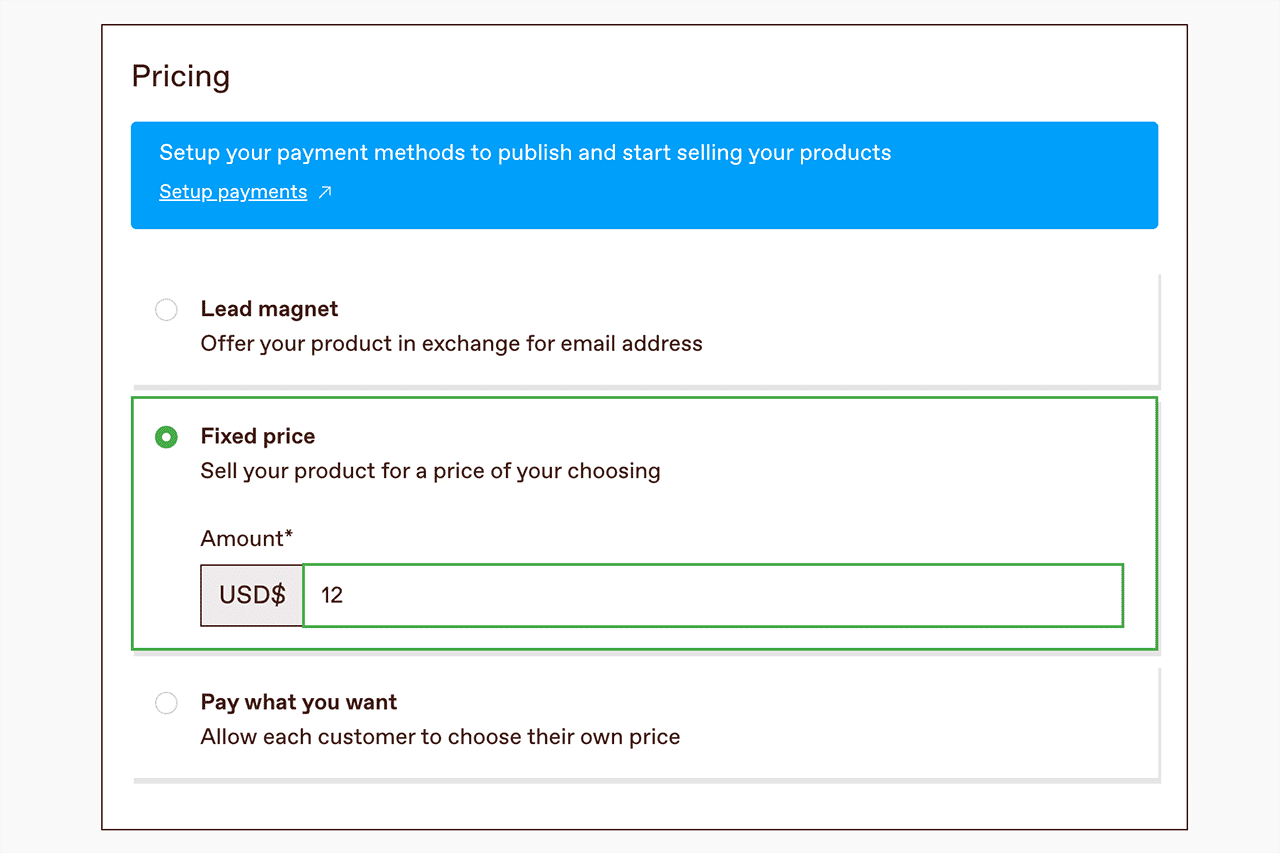
Step 4: Customize your online store
The Leap offers a variety of customizable themes you can choose from to give your online storefront a unique look. You can also personalize your store by uploading a profile picture and a cover image. Additionally, you can link out to your Instagram, TikTok, YouTube, LinkedIn, and more using built-in social media icons.
For a visual reference of what a Leap storefront could look like, check out this example from creator Kate Terentieva:
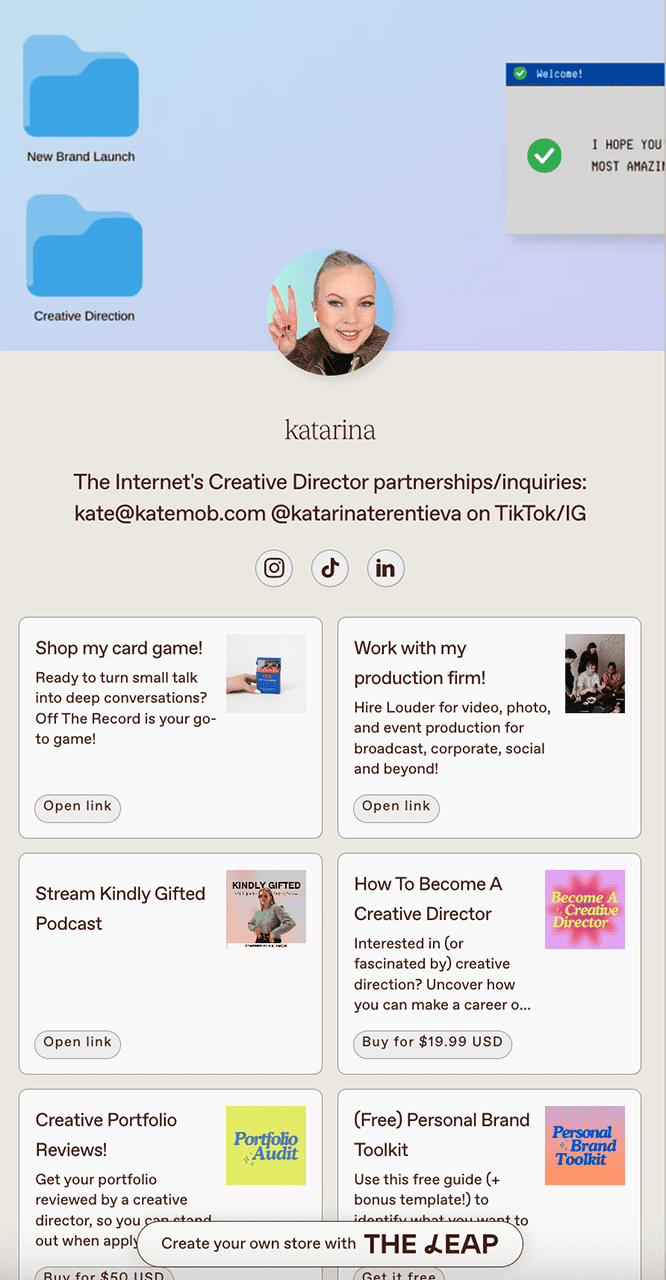
Step 5: Share your online store
Once you’ve finished building your Leap storefront, be sure to share a link to it with your audience. That means including your storefront link on your social media bio, content descriptions, and really anywhere else your audience might find it.
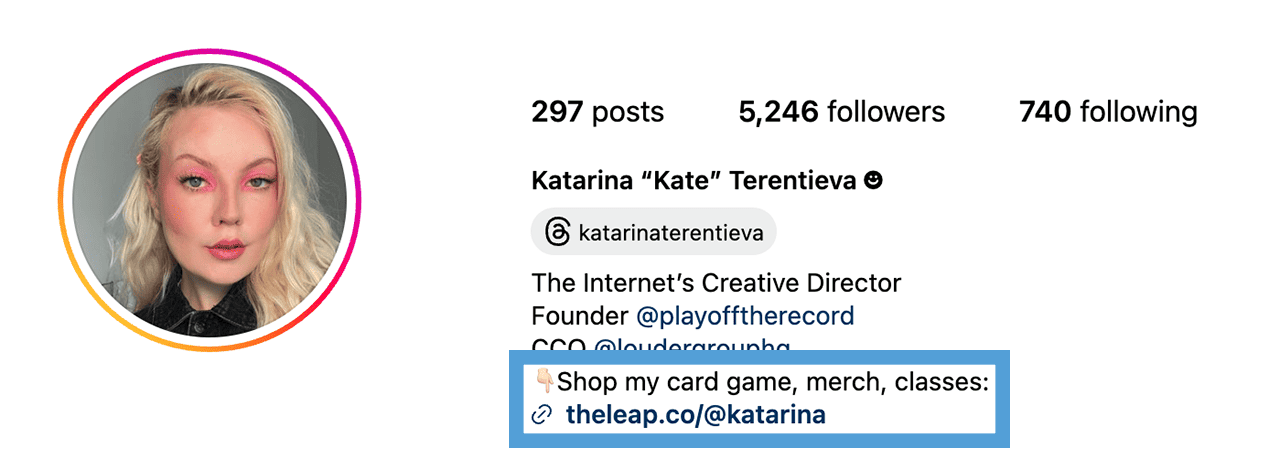
4. Promote your product through content
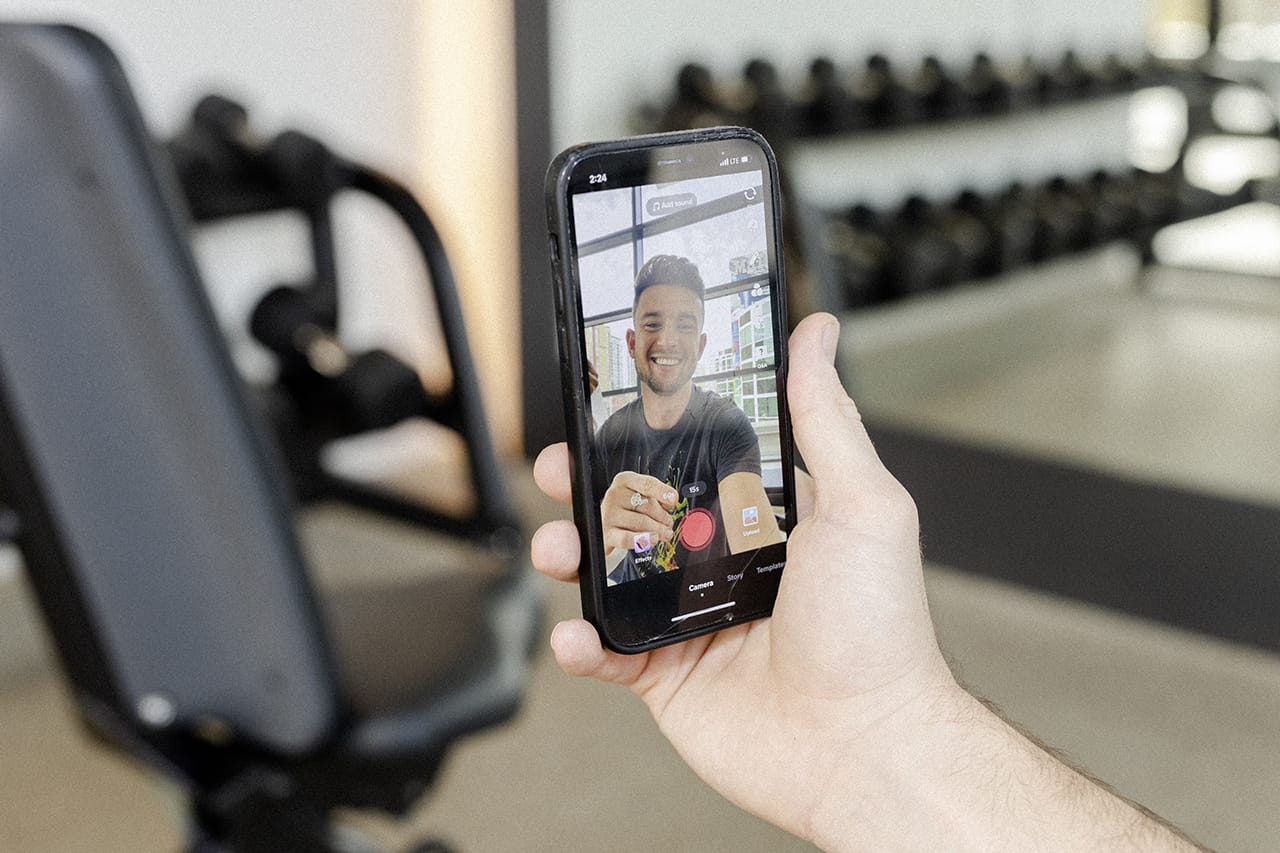
You’ve successfully created a digital product and you’re ready to sell it. Now it’s time to market it to your audience! Here are just a few ways you can promote your new digital product.
Mention your product in your content
You don’t want to use every piece of your content to promote your product, but you should definitely mention it when it’s appropriate. Publish at least one post that just talks about the product, then bring it up in other content when it makes sense. Use your best judgment here. If you’re talking about a related topic, then it could be a good idea to mention your product.
Create content about the product you’re selling
Adding to the point above, if you want to boost your sales, try integrating your digital product into your content strategy. Talk about the problems your product solves or create content about similar solutions, and naturally you’ll have opportunities to promote your product.
Include a link to your product in your content and social media bio
This should be a no-brainer, but you’d be surprised how easy it is to forget it! Make sure you add a link to purchase your digital product to the description or caption of your content. On YouTube, for instance, most creators insert links to their products in the description of each of their videos.
To make it easy for your audience to find your digital products, you should also include a link to your online store in your social media bio.
5. Build an email list

As a content creator, you’ve probably built an audience on your social media platforms of choice. But did you know there’s a better way to reach your following for important updates like a product launch? Email marketing might seem a bit old-school, but it still works.
Offer free resources as lead magnets
One of the easiest ways to grow your email list is by offering your audience free resources (or freebies) in exchange for their email addresses. With The Leap, you can do so by setting your digital product as a “lead magnet.”
Send out regular newsletters
To keep your audience checking their inboxes, deliver valuable content by email regularly, the same way you would on other content platforms. That way, when you announce your next product launch by email, they’ll already be used to checking in there — and will be more likely to make a purchase!
Promote your newsletter in your content
You can turn a good portion of your regular audience into an email list just by promoting your newsletter through your usual content. Just make sure that your newsletter offers something valuable that they’re not getting elsewhere.
6. Dip your toes in paid advertising

If you want to invest a bit of money into your digital product business, try advertising it. Every platform you can create content on has some way for you to advertise — though some are more worthwhile than others.
Try advertising on social media
A single sponsored post can go a long way. You don’t need to spend a lot of money to try this out. Rather, treat it as an experiment with a small budget. Whether your platform of choice is TikTok, Instagram, YouTube, or something else, look into commissioning an ad or two for your digital product.
Look into Google Ads
Google Ads get displayed in Google search results, on websites and blogs throughout the web, and in a ton of other places. That can potentially give your digital product a lot of visibility.
Partner with other creators
Who doesn’t love a good collab? Try securing sponsorship spots with other creators in your niche, work out an exchange where you promote each other’s products, or plan some other type of collaboration. Treat your fellow creators as collaborators rather than competitors, and you’ll go far!
7 Benefits of selling digital products online

Selling products in general is something every content creator should consider after they’ve built an audience. Whether you’re creating content full-time or as a side hustle, you should think of content creation as a business. Businesses rarely stick to a single product or service; they’re always looking for new opportunities to grow and bring in more revenue. Here’s why you should treat selling digital products as your next opportunity.
It helps create resilience
If a possible recession has been making you nervous, it might be time to look into creating and selling your own digital products. Marketing budgets are often first to get cut during a recession, meaning lucrative brand deals could become rarer. If brand sponsorships are a big part of your income, that can be really stressful.
When you sell digital products, you’re creating a new income stream that can shore up losses on the brand deal side of things. Now more than ever, it’s important to diversify your revenue streams as a creator.
You’re in control
Even huge content creators can find themselves at the mercy of social media platforms. Whether it’s YouTube updating its monetization policies or TikTok discontinuing its Creator Fund, it doesn’t take much for your income as a creator to be impacted by factors completely beyond your control.
Selling digital products gives you that control back. No matter what kind of digital download you choose to sell, you decide what you sell and how you do it.
You’re giving your audience more value
With digital products, you can bring a lot of value to your audience. Creator educators like Miss Excel, for example, often create courses, guides, and other digital products that fit naturally with the free content they offer. That free content is great, but offering products is the natural next step for creators who want to give more to their community.
When you’re trying to figure out what digital product you should sell, ask yourself what your audience really needs, not just what’s going to make you the most money. If you can identify that need — and come up with the best way to address it — then your product becomes another way you can help your audience.
Low cost of entry
Let’s say you want to sell merch. You have a strong brand and a brilliant idea for your first few designs. That’s great! However, unless you have the necessary skills to take a T-shirt design from that initial idea to a finished product, you’re going to need a lot of help and money to make that happen.
Even if you use a print-on-demand service that prints, packages, and ships merch for you, you’ll still need some way to turn your idea into an actual product. That means you’ll either need to invest in a graphic designer or learn that skill yourself. And since there’s no guarantee that your merch will take off, you could potentially sink a lot of money into an investment that doesn’t pay off.
Digital products, on the other hand, are a lot cheaper to produce, easier to get to your customer, and don’t need to be physically stored anywhere. That means you can launch a digital product more quickly for a lot less. And if you use The Leap to create and sell digital products, it’s all free!
Simple logistics
“Logistics” refer to everything that needs to happen in the messy middle between you creating a product and your customer receiving it. In the world of physical products, these logistics involve manufacturing, sourcing vendors, warehousing, transporting goods, and more.
In contrast, selling digital products is a lot simpler. This is because digital products don’t require repeated production, physical storage, or shipping. They’re accessible online in just a few clicks. You only need to create a digital download once, and it can be sold over and over.
With The Leap, you can create digital products in a snap to start making that passive income. Whether you want to make ebooks, Canva templates, or mini-courses, you can easily sell them on your Leap online storefront.
Higher profit margins
Another benefit of selling digital products vs. physical products is being able to keep more money in your pocket.
Because your initial investment is lower, you can whip something up and get it out the (digital) door with less money. And the costs of delivering that digital product to your audience are a lot cheaper, too. That means you can keep more money from each sale rather than giving it to a list of suppliers, manufacturers, and other vendors.
Easily scalable
“Scalable” is a business term that defines how easy it is to grow something quickly — usually a service or a product.
As a content creator, scalability is something you’re probably familiar with, even if you didn’t know the term for it. Say you’re a YouTuber, you have to strike a balance between how hard you work on an individual video, and how many videos you make each week. If you’re only creating content part-time, putting 5-10 hours into every video isn’t scalable.
Digital products are way more scalable than physical products. Since the logistics of selling digital products are simpler and more straightforward, and the investment required to scale is smaller, you can go from offering just one product to a whole range of products a lot faster.
Additionally, because there’s no inventory to manage, you don’t have to worry about finding creative ways to deal with increased demand. While physical products require additional costs and infrastructure as demand increases, digital products don’t.
Get the free digital product launch checklist!
Ready to create and sell your first digital product? Download The Leap’s free digital product launch checklist for more useful tips on how to unlock this revenue stream.
FAQ
How can you create digital products to sell online?
One of the biggest advantages of digital products is they’re a lot easier to produce than physical products. In just six steps, you can have your own digital products to sell:
- Research the kind of product you want to sell.
- Build your product.
- Set up an online store to sell your product.
- Promote your product with content.
- Build an email list.
- Try paid advertising.
Stuck on the “build the product” step? That’s where The Leap comes in.
The Leap is a free, AI-powered tool designed to help creators build digital products in a snap. Even if you have absolutely no idea what to sell, The Leap can help you get from the thought of “I should sell digital products” to a full-stocked online storefront, quickly and easily. Try it yourself today.
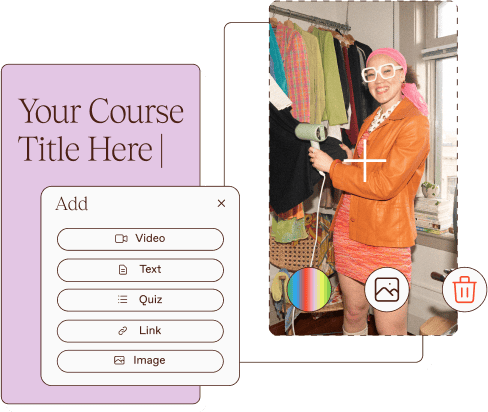
Create and sell digital products in minutes using The Leap!
How do you make money online selling digital products?
At the core of it, when you start selling digital products, you make money as soon as people start buying them. But to give your product the best chance of success, you need to set the right price and build a strategy that gets it in front of the right audience. Here are some ways you can do that:
- Build a value ladder. That means creating a series of products that offer progressively more value as they go up in price. That way, you’ll have something for every customer.
- Pick the right pricing model. Choose between a value-based (pricing based on what your product offers), cost-based (pricing based on what you paid to make the product), or competitor-based approach (pricing based on the competition).
- Choose the right promotion method. Many creators assume that all they have to do to promote their digital products is slapping a link to them in their social media bio. In reality, there are ways you can promote your products through your regular content without alienating your audience. Here are just some ideas.
Follow The Leap on TikTok, Instagram, and YouTube for more monetization tips for creators. We also make a newsletter.

